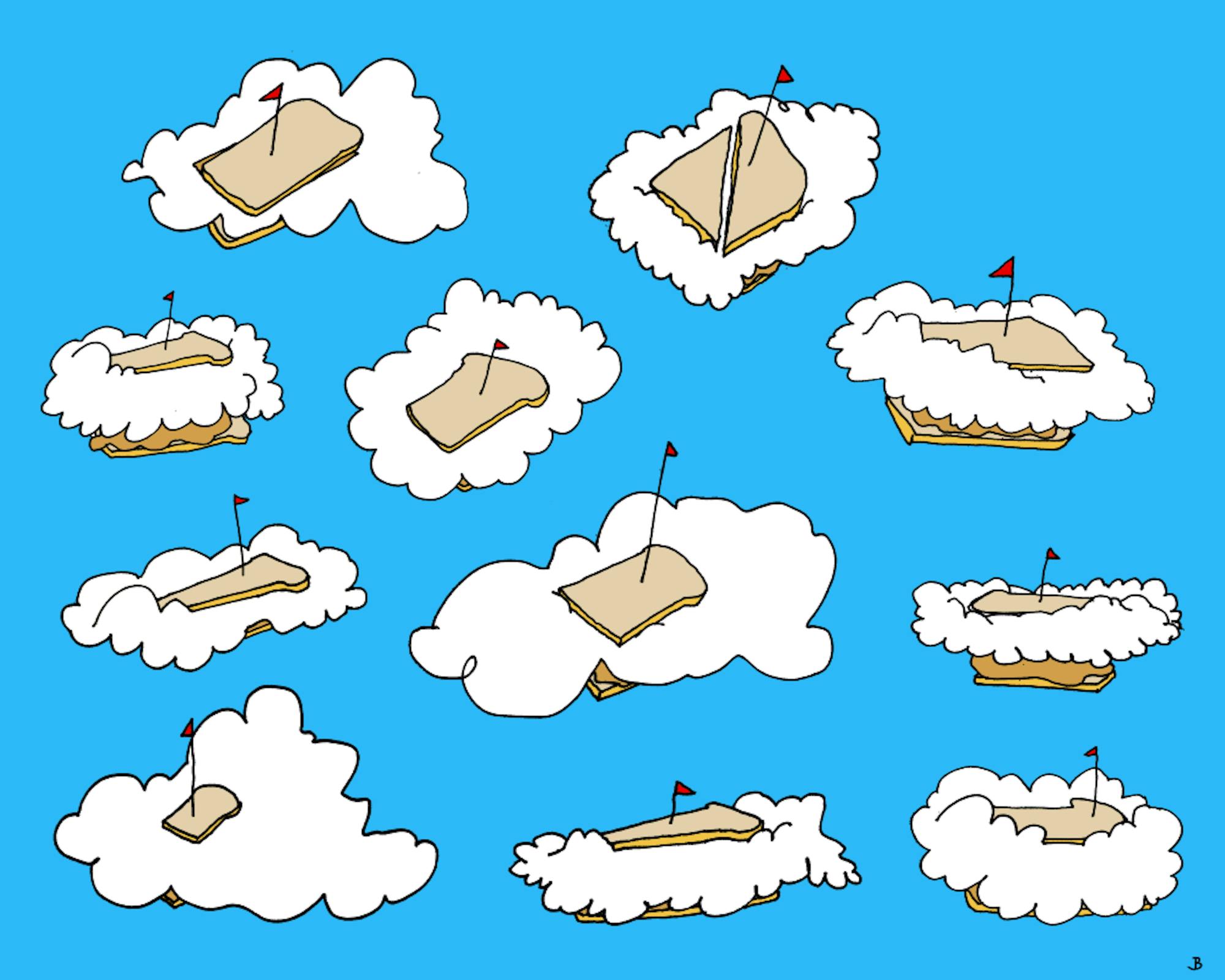A brief history of Fluff
Dried egg whites, sugar syrup, corn syrup and vanilla flavoring are all that make up Fluff, a marshmallow creme.
Boston in the late 1800s and early 1900s was a honeycomb for food innovation, with recipes for marshmallow creams circulating around the city in church cookbooks, newspapers and commercial kitchens.
Many factors came together to make Boston the site of Fluff’s creation and industry. Full of recent immigrants from Europe who brought with them their knowledge of candy making, Boston’s sweet tooth flourished. It wasn’t uncommon for residents to be frequented by freelance confectioners going door to door.
Boston was also a hub for food innovation. In 1853, an East Boston refinery revolutionized the sugar production process, producing a more refined sugar that didn’t require grinding and allowing for more precise measurements. Also, the invention of the hand-cranked eggbeater, soon followed by power mixers, made kitchen time more efficient.
But Boston had more than just machinery to account for its accession to America’s candy-making capital. Culinary experts like Fannie Farmer trained the next generation of confectioners and cooks.
Her cooking school produced hundreds of culinary professionals who were then employed by many of Boston’s restaurants and sweets shops. Published in 1896, Farmer’s mammoth 567-page cookbook became a classic American culinary text and featured many recipes with the use of marshmallow in sweets — and a few in salad dressing. It wasn’t until 1916, however, that today’s conception of Fluff entered the scene.
Archibald Query was a Canadian emigree and freelance confectioner. Credited with the development of the first and only Fluff recipe, Query went door to door in Somerville’s Union Square selling the sticky, sweet treat.
In 1917, Query’s marshmallow creme caught the attention of two World War I veterans, Allen Durkee and Fred Mower, who bought the recipe for $500 — roughly $6,000 today. Having attended elementary school together and served in France together during World War I, Durkee and Mower were tight-knit, with matching license plates to prove it.
After purchasing the recipe, they set up shop in their home kitchens, selling the product at the price of $1 per gallon. In 1929, Durkee and Mower opened a factory in Lynn, Mass., and began producing Fluff as we know it today. For more than a century, the recipe has remained unchanged.
The product has become a regional staple thanks to Durkee-Mower, according to Mimi Graney, author of “Fluff: The Sticky Sweet Story of an American Icon” (2017). In the mid-1900s as Durkee-Mower was making a push to go national, the food conglomerate Kraft was buying up small marshmallow creme factories across the nation. Durkee-Mower’s resistance to Kraft’s hegemony meant Fluff kept its market share in the New England area, but couldn’t expand to the same extent elsewhere. Later, Kraft sold off its marshmallow creme division, and Durkee-Mower remained. Durkee-Mower still makes Fluff in Lynn, Mass.
The annual “What the Fluff?” festival and New England’s unique appreciation for Fluff
From the early years of circulating the streets of Somerville, Fluff has made its way across the region and all the way to the International Space Station.
Perhaps the only fact necessary to understand New England’s insatiable appetite for Fluff is that of the 8 million pounds produced by Durkee-Mower annually, half is consumed within New England.
Many New Englanders, especially those in Massachusetts, have warm memories when it comes to Fluff. With its red, white and blue packaging unchanged since the 1960s, it is often associated with childhood memories.
“You often get introduced to it as a treat when you're a kid,” Graney said. “So people always associate it with their own childhood and that sense of home, whether it's making fudge with your mom or with ice cream, hot chocolate or whatever, it's got that real comfort food aspect.”
In 2006, Mimi Graney got an idea: a festival dedicated to Fluff. First introduced as a one-time celebration, the festival has become an annual tradition in Union Square, growing from 800 attendees initially to more than 10,000 in recent years. Erica Jones, emcee for this year’s virtual Fluff festival, calls it “the best fluffin’ event.”
“Typically, Fluff Festival is a jam packed end-of-summer festival in the heart of Union Square where you are experiencing an exciting day of activities, arts, music, culinary fun, games and much more all related to the idea and celebration of Fluff,” Jones wrote in an email to the Daily.
Jones, who worked at Somerville Media Center for eight years and covered the event annually, said the event has become a staple for the Somerville community.
“It is an impressive story of success and how curiosity really draws people to Somerville which is known for its artsy, quirky events,” Jones wrote. “Many of the local restaurants, businesses and community groups join in on the fun by creating new recipes or activities using … in one way or another… Fluff!”
The festival features many surprising applications of Fluff: as hair styling gel, robotics, an artistic muse and the centerpiece for imaginative recipes. Graney recalls long lines at the first Fluff festival as people waited to try her brother’s unusual hors d'oeuvres, which consisted of tuna fish, pickles, saltine crackers, mustard, hot sauce and Fluff.
“One of the highlights was my brother played the role of the tuna fluffer,” Graney said. “He piled it all up on a little cracker, and people stood in line, like a ridiculous line, to eat one of these. And I thought, ‘these people will eat anything with marshmallow fluff.’”
The next year, Graney and other festival organizers visited Somerville restaurants encouraging them to “give us any kind of crazy food you've got.”
Due to the ongoing COVID-19 pandemic, this year’s event hosted a livestream music performance, encouraged people to post videos of themselves eating strange food combinations that included Fluff and trivia, among other events.
Jones said the organizers of this year’s event were successful in recreating the atmosphere of past festivals online.
“The Fluff team did a tremendous job at retaining the energy of supporting local businesses throughout its virtual event,” Jones said. “They truly kept alive the soul and spunk of ‘What the Fluff’ just in a safe way because of circumstances beyond their control.”






